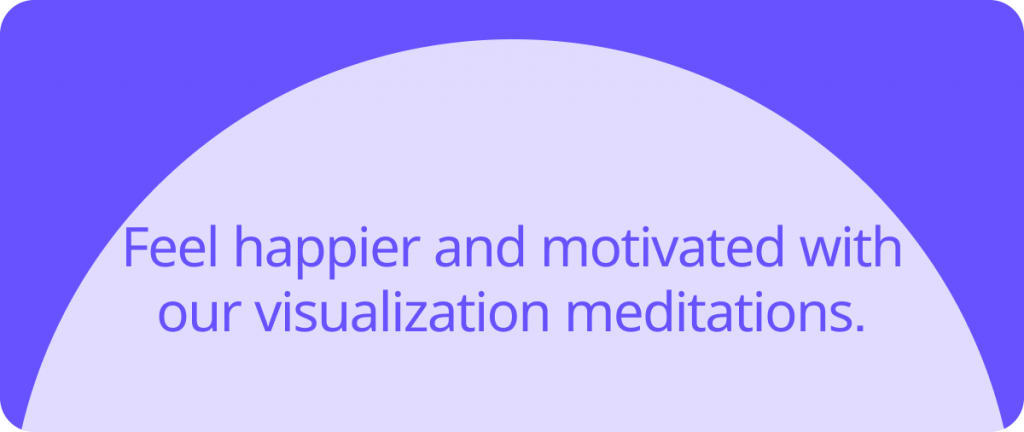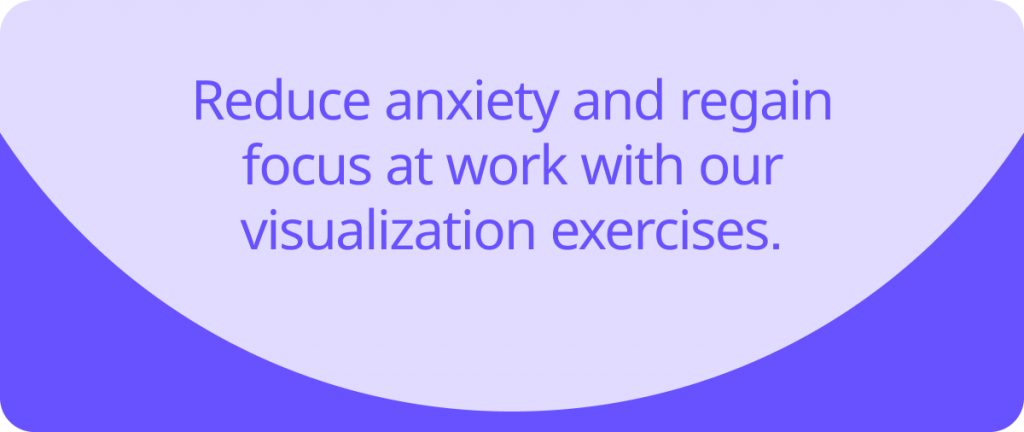Visualization exercise: 3-minute Visualization to Reduce Anxiety

Table of contents
Imagine your favorite place in the world. Now try to feel, smell, and hear everything that brings that place to life. Maybe it’s the smell of fresh air or freshly baked cookies, it could be a lonely beach you discovered a few summers ago. Does that memory make you feel relaxed and happy? Well, congrats, you just did your first visualization exercise.
In this article, we’ll delve into how visualization can be your key to unlocking inner peace and reducing anxiety. We’ll explore the science behind this technique and provide practical steps to help you incorporate it into your daily routine. Say goodbye to anxiety, and join us on a journey to discover the transformative power of visualization.

What Is The Meaning of Visualization?
Visualization is a remarkable technique that harnesses the immense power of your mind to reduce anxiety and improve overall well-being. At its core, visualization is the practice of using your imagination to create vivid mental images or scenarios. It involves immersing yourself in a mental “movie” where you visualize a peaceful, calming, or positive experience. By engaging your senses and emotions in this mental journey, you can effectively reprogram your mind and body’s response to stress.
Visualization works by tapping into the brain’s ability to simulate experiences. When you vividly imagine a peaceful scene, your brain responds as if you were truly experiencing it.
This triggers a cascade of physiological responses, including the release of relaxation hormones like serotonin and endorphins. As a result, your heart rate decreases, muscle tension eases, and stress hormones, such as cortisol, diminish.
Visualization is also a type of meditation. You can read more about other types in our blog.
The Science Behind Visualization and Anxiety Reduction
Studies have shown that regular visualization practice can lead to significant reductions in anxiety levels. Functional MRI scans have demonstrated that when we visualize calming scenarios, the brain’s amygdala, responsible for processing emotions like fear and anxiety, becomes less active. Additionally, the prefrontal cortex, responsible for rational thinking and decision-making, becomes more engaged, helping us gain better control over our emotions.
Moreover, visualization enhances our sense of self-efficacy and empowerment. When we repeatedly visualize ourselves successfully coping with stressful situations, we build confidence in our ability to handle them in real life. This positive reinforcement further reduces anxiety.
According to the World Health Organization, around 4% of the global population has experienced an anxiety disorder. That’s more than 300 million people. There are many therapeutic approaches to managing this condition, and visualization can be a powerful tool to support your journey.

Benefits of The Visualization Technique
A visualization technique offers a myriad of benefits that extend far beyond the immediate moment of practice. Let’s explore some of them:
- Anxiety reduction
- Enhanced mental clarity and creativity
- Improved confidence
- Stress management
- Better sleep
- Emotional regulation
- Increased positivity
- Reduced blood pressure and enhanced pain management.
Create a Comfortable Environment for a Visualization Exercise
The right environment can significantly enhance your visualization experience. Here are some tips to create a conducive setting, and below, you’ll find a short visualization exercise to help you fall asleep tonight.
- Find a Quiet Space: Seek out a peaceful and quiet place where you won’t be disturbed. This could be a cozy corner of your home, a tranquil garden, or even a park.
- Eliminate Distractions: Silence your notifications, lower the curtains, and minimize any other potential distractions.
- Comfortable Seating: Choose a comfortable chair or cushion to sit on. Relaxation is key to effective visualization.
- Lighting: Soft, natural lighting is ideal. Dim the lights if necessary to create a calming ambiance.
- Props and Aids: Some people find it helpful to use props like candles, essential oils, or soothing music to enhance their visualization experience. Experiment to find what works best for you.
Now, click the video below and enjoy our free visualization meditation.
Best Times and Frequencies for Doing the Visualization Exercise
- Morning Routine: Starting your day with a 3-minute visualization exercise can set a positive tone for the entire day. It helps you build resilience to stress and maintain a calm mindset.
- Before Stressful Events: Prior to situations that trigger anxiety (e.g., meetings, presentations, exams), take a few minutes to visualize a successful outcome. This can boost your confidence and reduce anxiety.
- Before Bed: A visualization session before bedtime can help you unwind, release the day’s tensions, and promote better sleep.
- Frequency: Aim to practice visualization daily or whenever you feel overwhelmed by anxiety. Consistency is key to reaping the long-term benefits.
Tips on Maintaining Focus and Relaxation During Visualization
- Deep Breathing: Start by taking a few deep, slow breaths to calm your body and mind. Inhale deeply through your nose, hold for a moment, and exhale slowly through your mouth.
- Use Guided Visualization: If you’re new to visualization, consider using our guided meditations to lead you through the process. They can help you stay on track and visualize effectively.
- Engage Your Senses: Feel the warmth of the sun on your skin, hear the sounds of nature, and smell the fragrances around you.
- Stay Patient: Don’t worry if your mind occasionally wanders during visualization. Gently bring your focus back to the scene you’re imagining. It takes practice to maintain concentration.
Final Thoughts
Now that you’re armed with the knowledge and tools to combat anxiety, we encourage you to take action. Start incorporating the 3-minute visualization exercise into your daily routine.
Remember, it only takes a few moments to experience its benefits, and consistency is key. Whether it’s in the morning, before challenging situations, or as a prelude to sleep, this practice can make a profound difference in your life.

